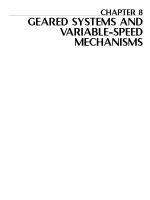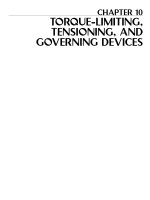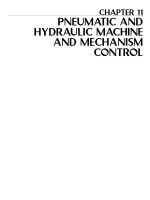Cre chapter 2
Bạn đang xem bản rút gọn của tài liệu. Xem và tải ngay bản đầy đủ của tài liệu tại đây (440.92 KB, 35 trang )
CHAPTER 2
INTERPRETATION OF BATCH
REACTOR DATA
REACTION RATE EQUATION
A rate equation characterizes the rate of reaction
Its form may either be suggested by theoretical
considerations or simply be the result of an
empirical curve-fitting procedure.
The value of the constants of the equation can
only be found by experiment; predictive methods
are inadequate at present.
The determination of the rate equation is usually a
two-step procedure:
the concentration dependency is found at fixed
temperature
the temperature dependence of the rate
constants is found, yielding the complete rate
equation.
MONITORING THE BATCH REACTOR
1. By following the concentration of a
given component.
2. By following the change in some
physical property of the fluid, such as
the electrical conductivity or refractive
index.
3. By following the change in total
pressure of a constant-volume system.
4. By following the change in volume of
a constant-pressure system.
ANALYZING KINETIC DATA
Integral methods
The integral method is easy to use and is
recommended when testing specific mechanisms,
or relatively simple rate expressions, or when
the data are so scattered that we cannot reliably
find the derivatives needed in the differential
method. The integral method can only test this or that
particular mechanism or rate form
Differential methods :
More complicated situations but requires more
accurate or larger amounts of data.; the
differential method can be used to develop or
build up a rate equation to fit the data.
2.1. CONSTANT-VOLUME BATCH
REACTOR
constant-density reaction system
V = const
1 dN i 1 d(C i V ) 1 C i dV V dC i dC i
ri
V dt
V dt
V
dt
dt
1 dpi
ri
RT dt
(2.1)
(2.2)
ANALYSIS OF TOTAL PRESSURE DATA
OBTAINED IN A CONSTANT-VOLUME
SYSTEM
p A N A N A0 a. x N A0
a N N0
CA
RT
V
V
V
n
V
Or
a
p A C A RT p A0
(P P0 )
n
For R
p R C R RT p R0
r
(P P0 )
n
(2.3)
(2.4)
2.1.1. INTEGRAL METHOD OF
ANALYSIS OF DATA
General Procedure
1) Assume the rate equation
dC A
rA
kf(C)
dt
dC A
kdt
f(C A )
CA
t
dC A
F (C A ) k dt kt
2) Intergrate
f(C A )
C A0
0
3) Calculate F(CA) by experimental data
4) Plot F(CA) vs. t
5) If the fit is unsatisfactory, another rate
HOW FIT OR SATISFY
(1) IRREVERSIBLE UNIMOLECULAR-TYPE
FIRST-ORDER REACTIONS
A
products
dC A
k CA
dt
CA
t
dC A
k dt
CA
C A0
0
CA
ln
kt
C A0
CONVERSION, XA
N A N A0 (1 X A )
N A N A0 (1 X A )
CA
C A0 (1 X A )
V
V
dC A C A0 dX A
XA
t
dX A
k(1 X A )
dt
dX A
k dt ln (1 X A ) kt
1 XA
0
0
Caution. - dCA/dt = kCA 0,6.. CB0,4 are first order
but are not enable to this kind of analysis;
hence, not all first- order reactions can be
treated as shown above.
(2) IRREVERSIBLE BIMOLECULARTYPE SECOND-ORDER REACTIONS
A+ B
PRODUCTS
dC
dC
rA
A
dt
B
dt
k C A .C B
(2.12)
C A0 X A C B0 X B
rA C A0
M
C B0
C A0
dX A
k ( C A0 C A0 .X A )(C B0 C A0 .X A )
dt
rA CA0
XA
dX A
k C2A0 ( 1 X A )( M X A )
dt
t
dX A
kCA0 dt
(1 X A )(M X A )
0
0
C B . C A0
1 XB
M XA
CB
ln
ln
ln
ln
1 XA
M (1 X A )
C B0 . C A
M.C A
C A0 (M 1) kt (C B0 C A0 ) kt
M 1
CAUTION
a)
2A → products
dC A
rA
k C 2A kC 2 A0 (1 X A ) 2
dt
XA
1
1
1
.
kt
CA
C A0
C A0 1 X A
(2.14)
(3) EMPIRICAL RATE EQUATIONS OF NTH ORDER
dC A
rA
k C nA .
dt
C1A n C1A0 n ( n 1)kt, n 1
hay C
1 n
A0
1 X
1 n
A
1 (n 1)kt
(4) ZERO-ORDER REACTIONS
dC A
rA
k
dt
C A0 C A C A0 X A kt, n 1
(5) OVERALL ORDER OF IRREVERSIBLE REACTIONS FROM THE
HALF-LIFE T1/2
aA + bB
phẩm
→
sản
dC A
a
b
rA
k C A .C B
dt
If the reactants are present in their stoichiometric ratios, they will
remain at that ratio throughout the reaction. Thus, for reactants A and
B at any time CB/CA = b/a, and we may write:
b
dC A
b
b
a
b
rA
k C A .( C A ) ... k ....C Aa b ..
dt
a
a
dC A
hay
k ' C nA
dt
t 1/2
2n 1 1 1 n
'
C A0
k (n 1)
(6) IRREVERSIBLE REACTIONS IN PARALLEL
A → R, k1
A → S, k2
dC A
rA
k 1 C A k 2 C A (k 1 k 2 ) C A
dt
dC R
rR
k1 C A
dt
dC S
rS
k 2 CA
dt









